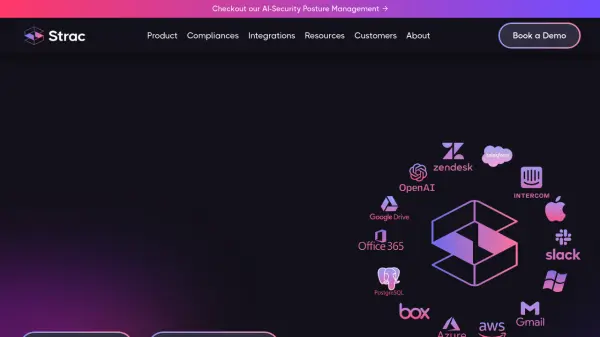What is Strac?
Strac enables organizations to discover, classify, and protect sensitive information—including PII, PHI, financial data, IP, and source code—across SaaS, cloud, endpoints, and generative AI environments. Leveraging advanced artificial intelligence and machine learning models, Strac delivers high-accuracy detection and continuous scanning for both unstructured text and documents such as PDFs, images, spreadsheets, and more.
The platform offers deep integrations with popular business applications, email, file sharing, cloud infrastructure, and communication tools, allowing for easy, no-code deployment. Automated remediation features include redaction, masking, access revocation, alerting, blocking, and deletion of sensitive data to maintain security posture and support compliance with leading standards like HIPAA, PCI DSS, SOC 2, ISO 27001, CCPA, and GDPR. Real-time and historical scanning combined with actionable insights help businesses mitigate risks and protect customer information at scale.
Features
- AI-Powered Sensitive Data Detection: Uses machine learning and OCR models to accurately identify PII, PHI, PCI, financial data, IP, and source code.
- Real-Time & Historical Scanning: Continuously monitors both legacy and new content across SaaS, cloud, and endpoints.
- Automated Remediation: Enables redaction, masking, access revocation, blocking, alerting, deletion, and labeling of sensitive data.
- No-Code Integrations: Easily integrates with email, collaboration, and productivity platforms like Slack, Gmail, Notion, Zendesk, Jira, Google Drive, Office 365, and more.
- Compliance Automation: Supports HIPAA, PCI DSS, SOC 2, ISO 27001, CCPA, and GDPR compliance with automated controls and reporting.
- Access Governance: Identifies risky, inactive users, misconfigurations, and monitors third-party plugin and OAuth risks.
- Generative AI Data Loss Prevention: Safeguards data shared with AI models such as ChatGPT, Copilot, Gemini, and Claude.
- Cross-Platform Support: Offers endpoint protection for Mac and Linux in addition to cloud and SaaS integrations.
- Customizable Remediation Flows: Allows users to tailor data classification and remediation actions to specific business or regulatory needs.
Use Cases
- Protecting sensitive customer and employee data across emails, documents, and SaaS collaboration tools.
- Automating regulatory compliance for standards such as HIPAA, PCI DSS, SOC 2, ISO 27001, CCPA, and GDPR.
- Preventing data leaks in generative AI tools by detecting and shielding PII and confidential files.
- Monitoring and remediating security posture for cloud platforms and critical endpoints.
- Conducting continuous audits and automated access reviews to identify risks and vulnerabilities in business applications.
- Redacting or masking sensitive fields and files before sharing or external communication.
- Implementing company-wide data loss prevention across diverse cloud and endpoint ecosystems.
FAQs
-
What types of sensitive information can Strac detect and protect?
Strac can identify and remediate a wide range of sensitive data, including personally identifiable information (PII), protected health information (PHI), payment card information (PCI), financial records, source code, and intellectual property across multiple platforms and formats. -
Which SaaS and cloud applications does Strac integrate with?
Strac supports deep integrations with applications such as Slack, Gmail, Office 365, Google Drive, Notion, Zendesk, Jira, Intercom, Sharepoint, Salesforce, Box, and various others. -
How does Strac automate regulatory compliance?
Strac automates compliance by continuously scanning for sensitive data, enforcing classification and remediation policies, providing real-time alerts on potential exposures, and supporting reporting for industry frameworks like HIPAA, PCI DSS, ISO 27001, SOC 2, CCPA, and GDPR. -
Can Strac remediate data exposure risks automatically?
Yes, Strac can automatically remediate risks by redacting, masking, blocking, or deleting sensitive information, as well as revoking access or applying security labels according to predefined rules.
Related Queries
Helpful for people in the following professions
Strac Uptime Monitor
Average Uptime
99.72%
Average Response Time
291.7 ms
Featured Tools
Join Our Newsletter
Stay updated with the latest AI tools, news, and offers by subscribing to our weekly newsletter.











